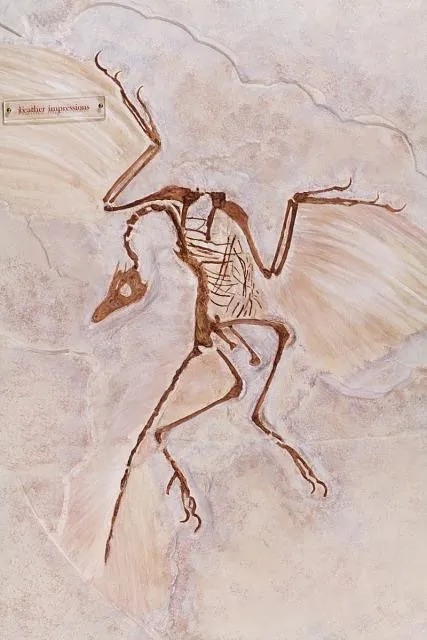NATIONAL MUSEUM OF NATURAL HISTORY
How We Lifted Flight from Bird Evolution
The path to flight in modern birds was full of forks, twists and dead ends.
/https://tf-cmsv2-smithsonianmag-media.s3.amazonaws.com/blogging/featured/A_small_aircraft_flying_alongside_a_flock_of_birds..jpg)
On December 17 in 1903, the Wright brothers achieved what humans had dreamed about since the earliest days of our species: soaring through the air. For millennia, visionaries watched birds take wing and wondered how they might do the same. Notes and inspiration from bird flight were integral in helping people finally achieve the goal, but our version of flying — as well as how we got there — contrasts starkly with that of birds.
While human flight came about through intense focus on a singular goal, flight in birds evolved incrementally over millions of years without direction. The path to modern birds was full of forks, twists and dead-ends.
Becoming birds of a feather
Paleontologists are still solving the puzzle of how flight came about, but one of the most widely accepted hypotheses involves small, bipedal dinosaurs that used flapping motions while running, similar to fledglings of modern birds.
“For a long time, the assumption was that gliding was stage one and flapping was stage two,” said Matthew Carrano, curator of Dinosauria at the Smithsonian’s National Museum of Natural History. “It seems clear now that the origin of flight in birds may not have started with gliding, but lots of flapping and fluttering.”
Carrano cited Kenneth Dial’s work at the University of Montana’s Flight Laboratory. He studies the way young birds use wings to run up trees. “You can imagine a situation like that, where some behavior that isn’t really flight becomes elaborated into flight,” said Carrano.
Paleontologists estimate that bird-relatives flew for the first time between the middle and late parts of the Jurassic period, about 160 million years ago. These aerialists were proto birds like Archaeopteryx, somewhere between dinosaurs and birds.

“The anatomical pieces of flight all appear before the animal could fly,” said Carrano. Feathers, for example, existed for tens of millions of years before flight. The ancestors of modern birds had also already developed large lungs, strong arm muscles and small, lightweight statures.
Eventually, after another 60 million years of incremental changes and extinctions, evolutionary experiments produced the masters of the air we see today — from acrobatic hummingbirds to soaring albatrosses. Through inspiration and careful observation of these marvels, humans have used bird flight to advance the goal of taking to the skies in our own unique way.
Winging it
Throughout history, humans dreamed of and attempted to fly by simulating the flapping wings of birds. In Greek mythology, wings made of wax and feathers carry Icarus through the sky and eventually too close to the sun. In 1505, Leonardo da Vinci wrote a codex on the flight of birds and designed — but never built — a flapping device for flight called an ornithopter.
“The stumbling block for the inspiration of natural flight into human flight was to emulate the way that birds fly with flapping wings,” said Peter Jakab, chief curator of the Smithsonian’s National Air and Space Museum.
Without the right weight, and shape or power for generating lift, flapping devices were doomed to fail. In this case, watching birds might actually have stalled progress.
“What birds do is so sophisticated, that to retro-engineer it 150 or 100 years ago is pretty daunting,” said Carrano. Bird flight is not the simplest or most efficient path to soaring through the skies. “You’re chasing down what evolution did, but evolution wasn’t trying to fly.”
Not everything was a false start, however. Watching birds glide inspired inventors to build gliders with stationary wings that have a curved shape to create lift. Engineer Otto Lilienthal pioneered the first real attempts to fly by studying birds intensely, even publishing a book in 1889 called “Birdflight as the Basis of Aviation.”

Finally free as a bird
People used soaring birds as early guides for creating lift and aerodynamic shapes, but before the Wright brothers, no one had figured out how to effectively control movement in larger aircraft. Lilienthal directed his gliders by shifting his body weight back and forth — similar to modern hang gliders — but the method was dependent on the size and weight of the aircraft.
Wilbur Wright wrote to the Smithsonian Institution in 1899 to request reports on current knowledge surrounding flight. In his letter, he said he wanted to “add [his] mite to help on the future worker who will attain final success.” Within five years, he became that future worker, when he and his brother Orville designed and flew the first successful airplane.
One of their keys to safe soaring — and steering — was a concept called wing-warping, which is mirrored in bird flight. By changing the wind-facing angle of the wings on one side, the Wright brothers realized you could increase the lift on one side, causing it to rise and turn the aircraft. They confirmed this idea by watching vultures glide in circles.
“Learning the secret of flight from a bird was a good deal like learning the secret of magic from a magician,” Orville once remarked. “After you once know the trick and know what to look for, you see things that you did not notice when you did not know exactly what to look for.”
Modern airplanes still use the differential lift concept – first realized through wing-warping — to balance and turn in the air.

An aerial view
For birds, successful flight resulted in a new explosion of evolutionary possibilities. “Flight can make all kinds of resources available, such as safer nesting sites and access to food,” said Helen James, curator of birds at the Smithsonian’s National Museum of Natural History. “It opens up more of the world.”
The ability to fly has done something similar for humans, changing the feel of the world and our perceptions of our species.
“What was considered a great distance before the airplane was much smaller than what we consider a great distance now,” said Jakab. “And on planes, you don’t see borders or human-created divisions,” he said. “That had a powerful psychological impact.”
Just as bird flight changed evolutionary history on Earth, it’s likely that the invention of human-powered flight will remain one of the most transformative moments of human history. The Wright brothers’ first powered airplane currently sits in the Smithsonian’s National Air and Space Museum. Jakab calls it a seminal object, like the first wheel. “You can look at it and argue that from this one object emanated many aspects of the modern world.”
Related stories:
Landmark Study Shares Smithsonian Bird DNA Collected Over Three Decades
Meet the Scientist Studying Vulture Guts for Clues to Disease Immunity
Scientists Describe New Bird Species 10 Years After First Reported Sighting

